March 2024 News
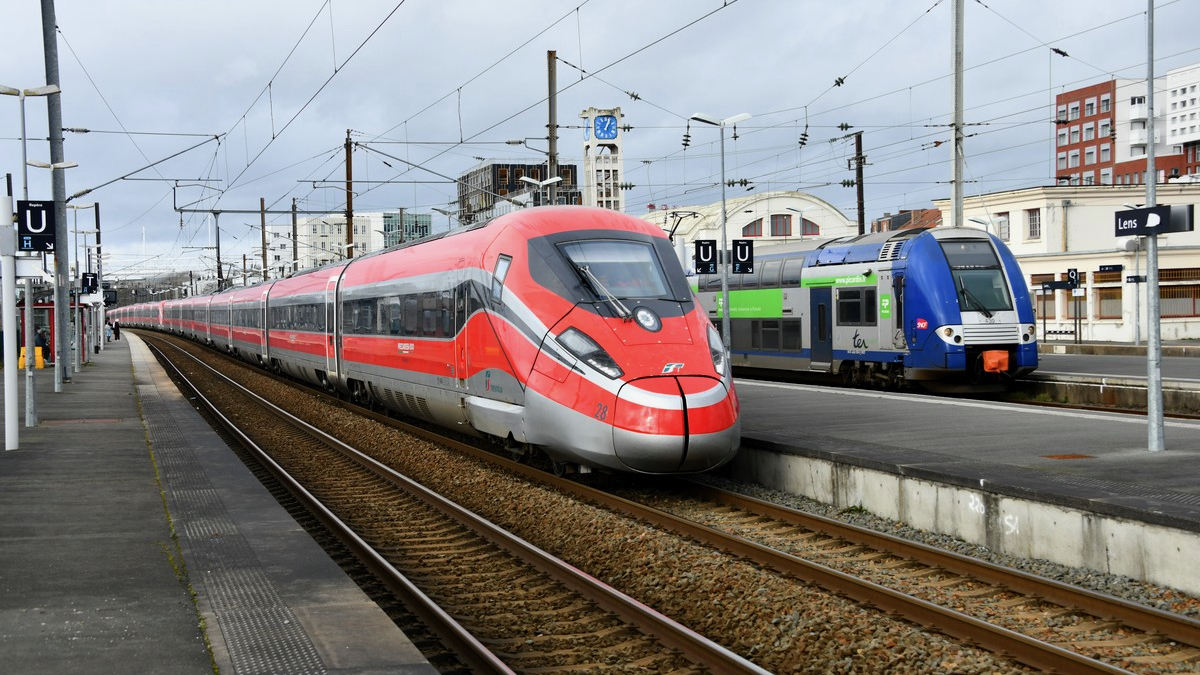
ETR 100 Frecciarossa multiple testing
Trenitalia's Frecciarossa units are currently undertaking tests with units 23 and 28 on LGV LN3 to obtain approval to run in multiple on the French network.
Part of the testing involves visual examination of the roof and pantographs that needs to be undertaken with the current switched off. The most suitable location is at Bully-Grenay between Lens and Béthune where power can be isolated on line 4 without affecting other lines. On 6th February the pair are seen (above) heading through Lens and opposite at Bully-Grenay with E4013 passing.
Photos: Didier Delattre.
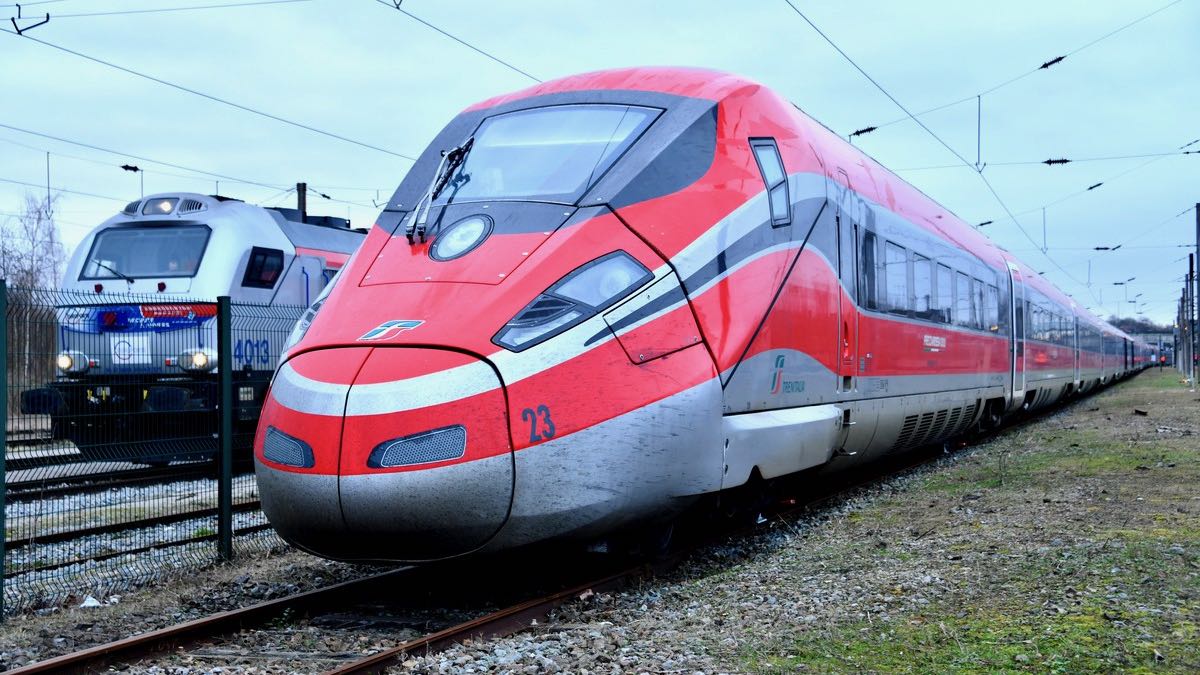
SNCF seeks tenders for next generation of bimode trains
SNCF is seeking expressions of interest for the next generation of small bimode regional trains incorporating hydrogen or battery propulsion. Following expressions of interest, SNCF is expected to issue invitations to tender on 15th March with the successful tenders forming umbrella agreements to supply up to 180 electric MUs with either hydrogen or battery secondary traction over the next 10 years. Both types must provide at least 120 seats within a maximum length of 59m and be able to operate at up to 160km/h using electric overhead current at both 1.5kV DC and 25kV AC. Interiors must include the ability to reconfigure to meet changing needs.
The first type (up to 30 trains) must also be able to operate with hydrogen propulsion providing a maximum speed of 140km/h and with a range of 600km. The second type (up to 150 trains) must be battery-equipped and capable of a maximum speed of 140km/h, with a range of at least 100km when operating from the battery. This version may also be equipped with a biofuel-powered diesel engine compliant with Euro V emissions standards (effectively trimode) or offer extended battery range of up to 200km.
The strongest contender would appear to be the former Alstom Reichshoffen plant now operated by CAF. Régiolis units are built here and there is already a four-car prototype hybrid diesel/battery conversion operating commercially from Toulouse since December. SNCF has also placed an order for 12 hydrogen-powered units with a top speed of 160km/h and range of 600km that should enter commercial service in 2025. Both the battery and hydrogen units are four-car versions and at 72m length are beyond the scope of the present tendering exercise, but there is also a three-car Régiolis available at 56.5m with 132 seats, although none has been ordered for use in France.
The first type (up to 30 trains) must also be able to operate with hydrogen propulsion providing a maximum speed of 140km/h and with a range of 600km. The second type (up to 150 trains) must be battery-equipped and capable of a maximum speed of 140km/h, with a range of at least 100km when operating from the battery. This version may also be equipped with a biofuel-powered diesel engine compliant with Euro V emissions standards (effectively trimode) or offer extended battery range of up to 200km.
The strongest contender would appear to be the former Alstom Reichshoffen plant now operated by CAF. Régiolis units are built here and there is already a four-car prototype hybrid diesel/battery conversion operating commercially from Toulouse since December. SNCF has also placed an order for 12 hydrogen-powered units with a top speed of 160km/h and range of 600km that should enter commercial service in 2025. Both the battery and hydrogen units are four-car versions and at 72m length are beyond the scope of the present tendering exercise, but there is also a three-car Régiolis available at 56.5m with 132 seats, although none has been ordered for use in France.
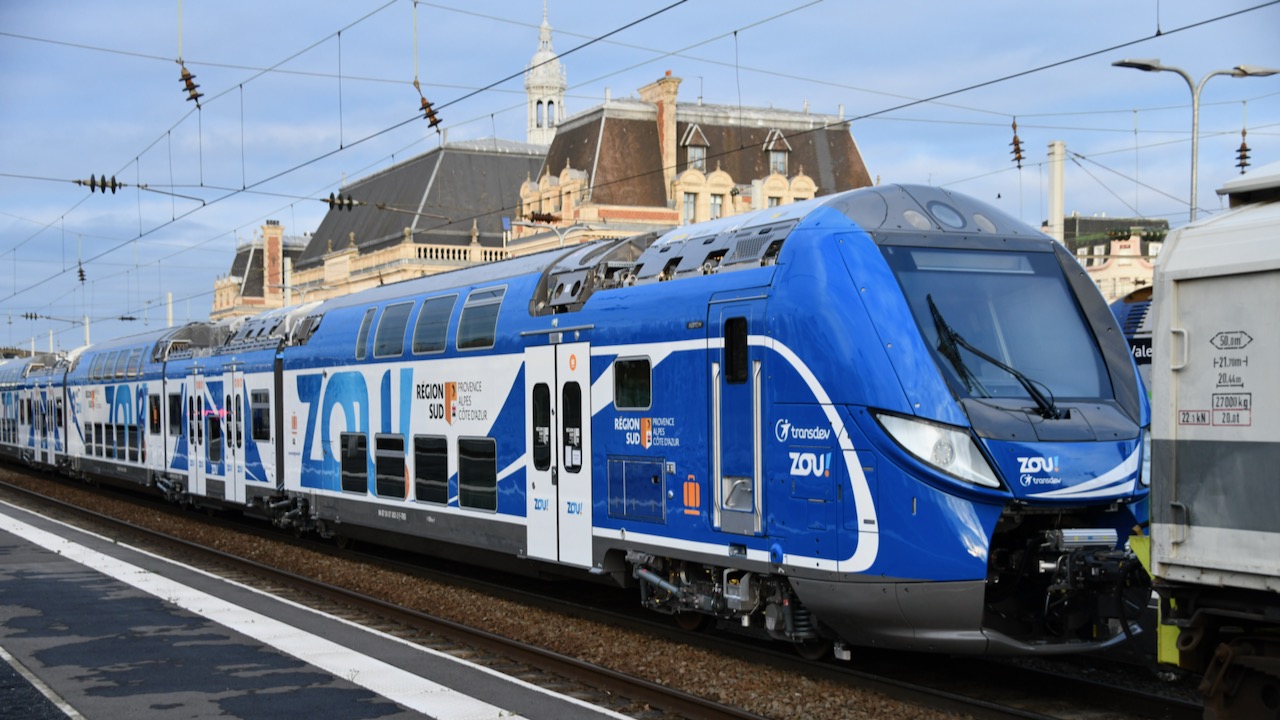
EU concern over last minute contracts
The European Union is concerned about the number of last-minute contracts agreed for publicly-funded services to avoid the deadline for competitive tendering on 24th December. Both Nouvelle-Aquitaine and Grand Est agreed new contracts with SNCF for TER service in the latter half of the year, while in 2022 Occitanie had renewed with SNCF despite the existing contract having three years to run. The period up to the December 2023 deadline was meant to be a transitional period with single-tender contracts only allowed in certain circumstances. The EU believes these conditions have not been met and that the new contracts infringe EU law.
France is not alone. There are similar situations in Italy and Denmark, and an investigation is already underway in the Netherlands. So far Pays de la Loire and PACA have competitively-tendered TER services. Apart from Transdev winning Nice – Marseille, SNCF has retained all of the contracts. AURA is currently preparing to tender its services this year
France is not alone. There are similar situations in Italy and Denmark, and an investigation is already underway in the Netherlands. So far Pays de la Loire and PACA have competitively-tendered TER services. Apart from Transdev winning Nice – Marseille, SNCF has retained all of the contracts. AURA is currently preparing to tender its services this year
Above. Transdev ordered 16 Alstom Omnéo eight-car EMUs on behalf of Région Sud PACA to replace BB 22200s and Corail stock used by SNCF on the Nice – Toulon – Marseille service that it will take over in summer 2025. The first unit in its distinctive blue and white ZOU! livery is seen passing through Valenciennes in November en route to Velim for testing. Photo: Didier Delattre.
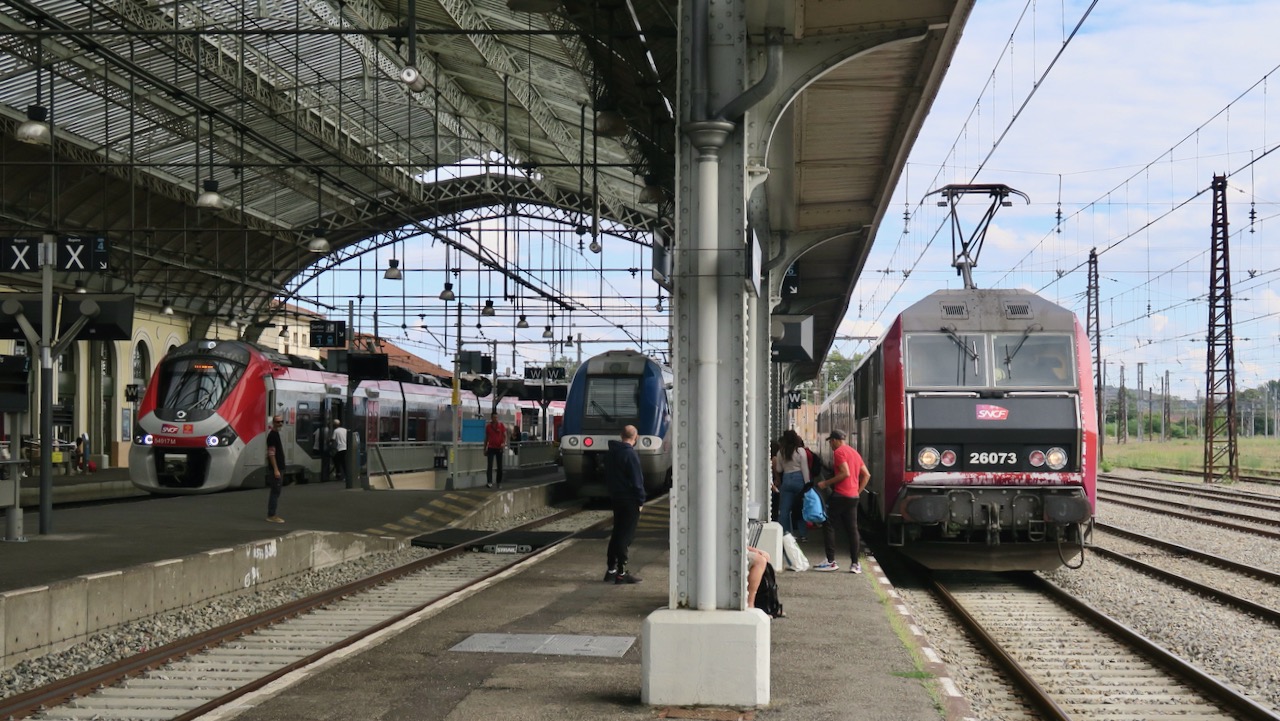
Rush hour at Montauban. On the 13th September Régiolis Z54917 has failed in the platform with the 15.51 Toulouse – Agen, next to it AGC Z27616 waits to depart with the 17.22 to Toulouse as BB 26073 arrives on the far platform with the 16.24 Toulouse – Paris Austerlitz. Construction starts this month of a footbridge and lifts to replace the constricted subway between the platforms (entrance seen between the Régiolis and AGC), along with the usual improvements to make the station fully accessible to PMR. The €12.5 million project will take 18 months to complete.

On the 7th February CMR BB 67611/67522 were used to move some fourgons and the shorter DEV AO B9c9 couchettes to Le Mans, that had been stored at St Jory for some years. The pair are seen running beside the canal at Pompignan as Train 418010 Saint-Jory – Angoulême, continuing to Le Mans the following day. Photo: Georges Turpin.
Grand Est TER to introduce compulsory reservations on Paris services
Grand Est TER is to introduce compulsory reservations from 5th July on its Fluo services to and from Paris Gare de l'Est. This will cover services from Paris to St-Dizier, Bar-le-Duc and Strasbourg on the Marne Valley line and to Troyes, Culmont-Chalindrey and Belfort on Line 4. Reservations will be free and are being introduced to manage overcrowding on many services as passenger numbers increase.
Apart from the two daily return Paris – Strasbourg and rush hour Paris – St-Dizier services operated with BB 26000 and six Corail push-pull sets, all of the services are operated by six-car Coradia Liner (Régiolis) units with seating capacity of 279. While some services are operated with a pair of Coradia Liners operating in multiple this only provides similar capacity to the 550 seats provided by the seven Corail rakes previously used. Passenger numbers on Marne Valley services have increased by 25% since 2018.
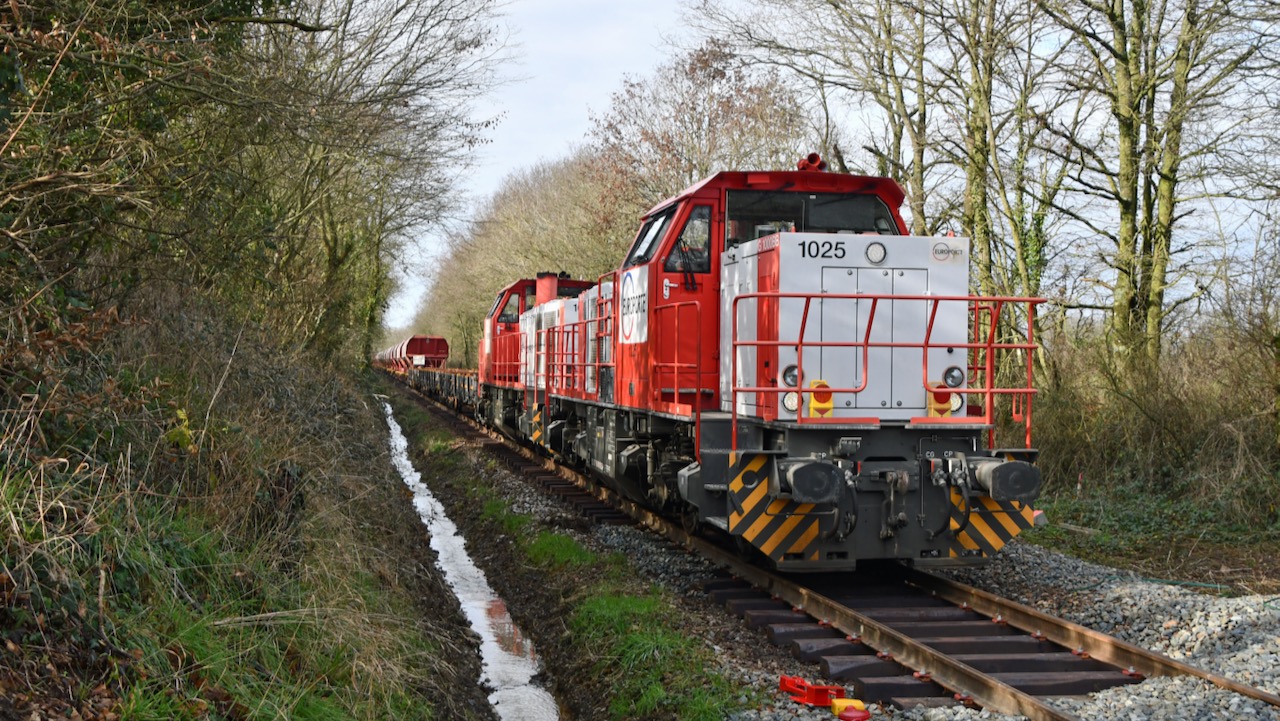
Château-Gontier good as new
Developed under the Plan de Relance, the project has been carried out by a consortium led by ETF, with local firm CLMTP relaying track at Gennes-Longuefuye, UIF which supplied recycled materials, and Terélian (Vinci group). The €33.7 million cost is financed by the State and Pays de la Loire région (35% each) plus 15% each from Mayenne département and Pays de Château-Gontier communauté de communes.
The upgrade should help the line attract new traffic in addition to the 80,000 tonnes moved annually for existing users. Slag from an industrial incinerator at Roussillon between Lyon and Valance comes in for processing by Séché Environnement, while Maisonneuve receives steel profiles and tube, mostly from Spain and Italy, for distribution across western France by lorry. Both firms are keen to transfer more traffic to rail. Maisonneuve has recently extended its warehouse at Château-Gontier and expects to raise tonnage from 45,000 to 60,000 tonnes a year, while Seché is expanding its terminal to accept longer trains and plans to increase traffic by about 20%.
In the longer term local authorities hope to revive the common-user freight terminal at Château-Gontier. This was served during the 2010s by a daily intermodal train to Lyon operated by Combiwest with traction supplied by Colas Rail. The terminal generated some 200,000 tonnes a year but loadings never reached breakeven point and Combiwest went bankrupt in 2016. There is currently no intermodal loading point in Mayenne département or in the whole of the Pays de la Loire région; that at Le Mans, revived by Combiwest, closed again in 2016.
From 31st May the service will run as before, Fret SNCF operating a twice-weekly wagonload train hauled by one or two Class BB 60000 locos from Saint-Pierre-des-Corps to Château-Gontier with a stop at Gennes-Longuefuye. The usual load is 10 bogie wagons carrying steel and eight wagons of slag in containers.
Many thanks to David Haydock for his assistance with preparation of this item.
Above. On 18th January Europorte France G 1000s Nos 1025 and 1029, on hire to ETF, were on ballasting duty near Gennes-Longuefuye. Photo: David Haydock.
Luchon rebuilding
Work is underway all along the route between Montréjeau and Luchon, the old track lifted, the alignment prepared for new track, clearing undergrowth and trees from embankments and cuttings, progress assisted by the mild winter weather. On 20th January Occitanie president Carole Delga visited the worksite at Marignac-Saint-Béat, one of the stations that will reopen when passenger service resumes in December. A few days earlier, she had officially opened the new cable car linking Luchon with its ski resort Superbagnères. This is known locally as La Crémaillère, a reminder that Superbagnères was originally reached by a rack railway, replaced in 1966 by the first cable car.
Below. At Luchon on 7th February track has been cleared from the station area and rail stockpiled prior to relaying. The ‘new’ rail is in fact recovered material from the Toulouse – Tarbes upgrade carried out over the past few years. A few masts remain in situ from the line’s electrification, abandoned on closure in 2014. Photos: Chris Bushell.
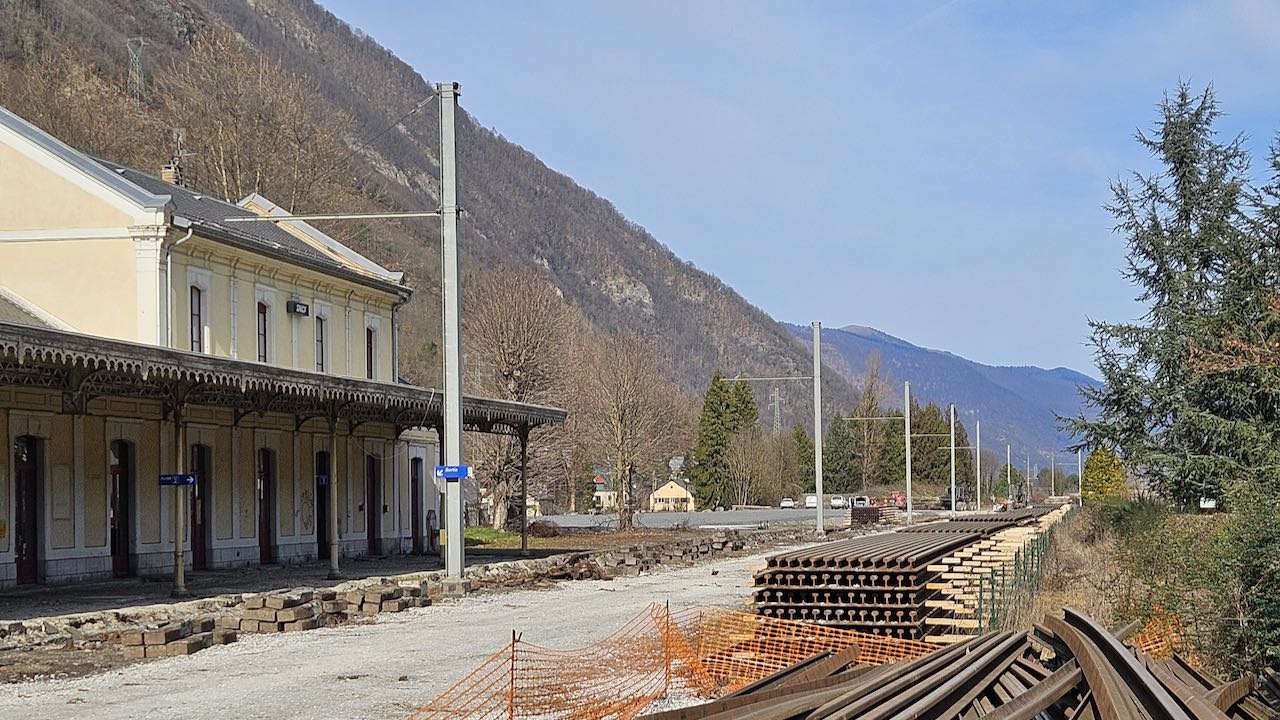
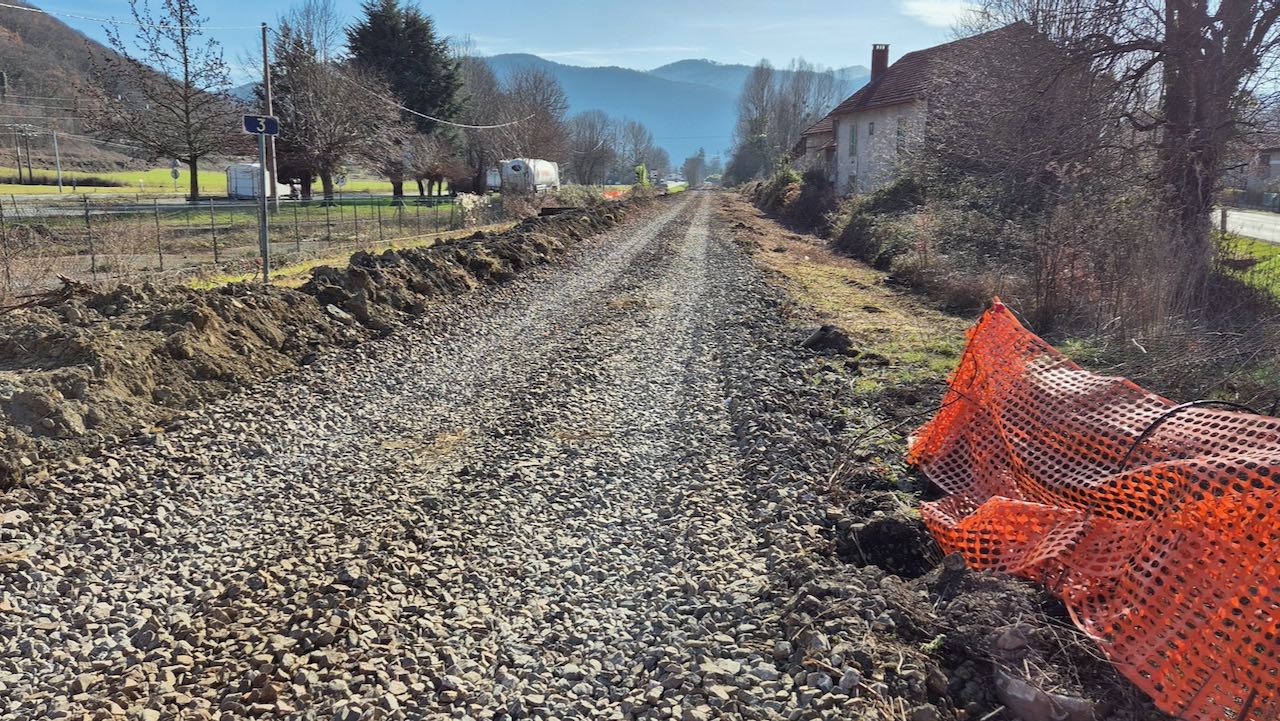
Aubrac secure?
Track renewal between Andelat and Loubaresse (26km) on the Ligne des Causses starts on 4th March, an eight-month job that will see the line closed between Neussargues and Saint-Chély-d’Apcher until 4th November. Life-expired double champignon rail dating from the 1930s will be replaced by modern materials after the long-running dispute over financing was resolved last summer when it was agreed that the State would fund the entire cost of €43 million. Presumably, the Saint-Chély steel traffic will need to be moved by road, whilst the work is taking placing place.
AURA and Occitanie had refused to contribute as the line between Neussargues and Saint-Chély-d’Apcher is used only by the single daily Intercités train and steel traffic to the ArcelorMittal works at Saint-Chély, thus falling outside their TER remit. Despite this, the two régions joined with the State in providing €1 million each towards the cost of studies prior to start of the works.
While relaying should ensure viability of the track for at least 10 years, the condition of the viaduc de Garabit remains a concern.
Significant remedial work is likely to be required in the near future, funding for which has yet to be found. Studies carried out for the transport ministry have identified expenditure of €500 million necessary over the coming decade to safeguard the Causses and Cévennes routes through the Massif Central. To celebrate the viaduct’s 140 years, a permanent open-air exhibit organised by Saint-Flour commune will be unveiled next month at one of the viewing areas, along with a programme of events throughout the year.
Opposite. A workbase has been established in the former goods yard at Saint-Flour, where new sleepers and ballast are stockpiled.
Photo: La Montagne/Jérémie Fulleringer.
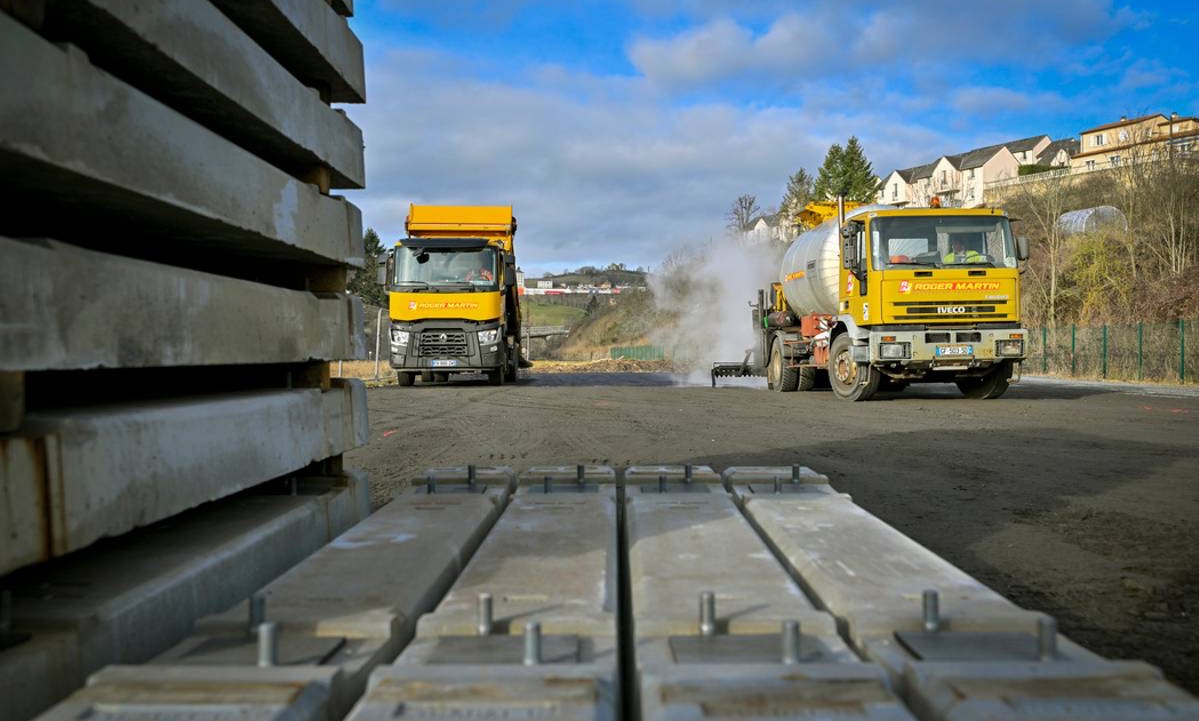
Rhône-Alpes LGV renewal
SNCF Réseau has opened a 15Ha depot at Pusignan, just north of Lyon-Saint-Exupéry TGV station, as its base for upgrading the 30-year-old Rhône-Alpes LGV. In the latest stage of modernising the Paris – Lyon – Marseille high-speed route, the 115km Rhône-Alpes LGV from Montanay to Valence will be reballasted over the next five years, with new turnouts and a new control system installed to raise capacity from the current 13 trains/h each way to 16.
Around 250 staff are based here, of whom 160 are employees of Eiffage and its subcontractors. A ballast train leaves the depot every night at 21.30, followed by a second at 22.45 after the last TGV has cleared the line. Work is carried out on 600m of track until 06.30 when the newly-ballasted section is reopened and can be traversed at 170km/h. During the current year, some 59km of track will receive new ballast.
Up to 70% of recovered ballast can be reused after cleaning and grading, the residue going for road repairs. Misting equipment has been installed to help reduce the amount of dust created. New ballast comes in by lorry from the Saint-Cécile quarries near Maçon.
Photos: Mesinfos.fr/Eric Seveyrat.
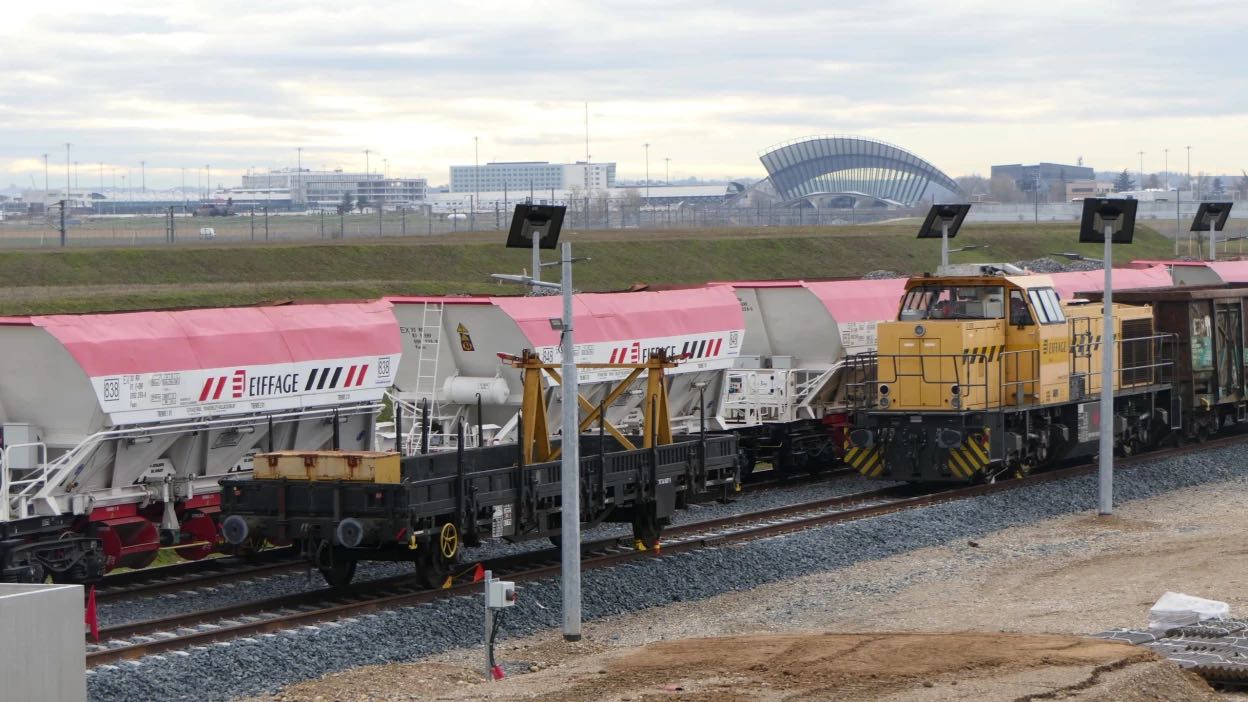

POLT two-thirds done
Meeting in Limoges the same day, SNCF’s teams involved in operating the route held a brain-storming session. After hearing representations from users, elected officials and pressure group Urgence Ligne POLT, a series of workshops sought ideas and proposals to ameliorate the line’s poor reliability, in addition to the emergency rolling stock maintenance programme already being implemented.
At a subsequent meeting it was announced that Class BB 26000s previously allocated to Centre-Val de Loire services would now be transferred to POLT to strengthen the locomotive fleet.
Commissioning of CAF’s Oxygène trainsets was said to be scheduled for ‘late-2025 or early-2026’, meaning a further two years’ service for life-expired Corail coaches, but with the promise of 11 return Limoges – Paris trains daily in 2h 49min against today’s best of around 3h 30.
Photo: Le Populaire du Centre/Christophe Péan.
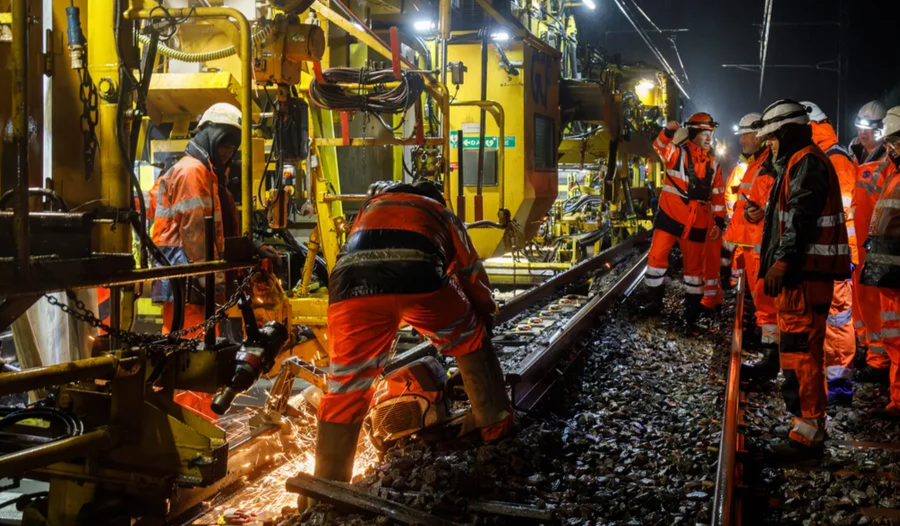
Austerlitz splendour revealed
A major stage in the renovation of Gare d’Austerlitz saw the restored grande halle officially opened on 7th February following removal of 3,000 tonnes of scaffolding. The second-largest after that at Bordeaux Saint-Jean, Austerlitz’s grande halle was completed in 1867. It is 280m long with some 15,000m2 of glazed roofing. Renovation has been the most ambitious and complex of all the restoration being undertaken at Paris stations, requiring work on 83 substantial timber supports, cleaning of 4,700m2 of façades, sand-blasting and restoration of corroded ironwork, and replacement of roof-lights.
Major works continue elsewhere in the station, with completion scheduled for 2027; annual passenger throughput is expected to rise from today’s 22 million to over 30 million.
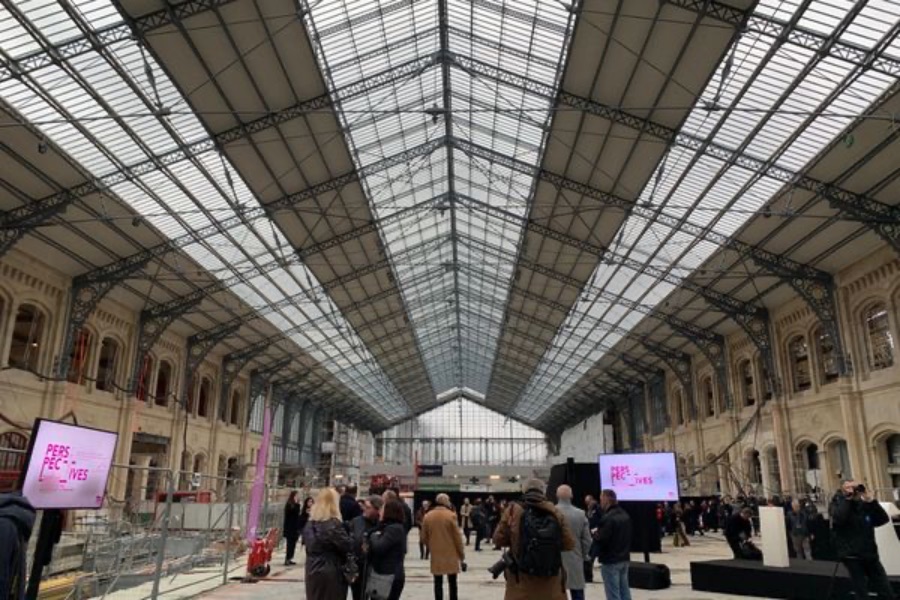
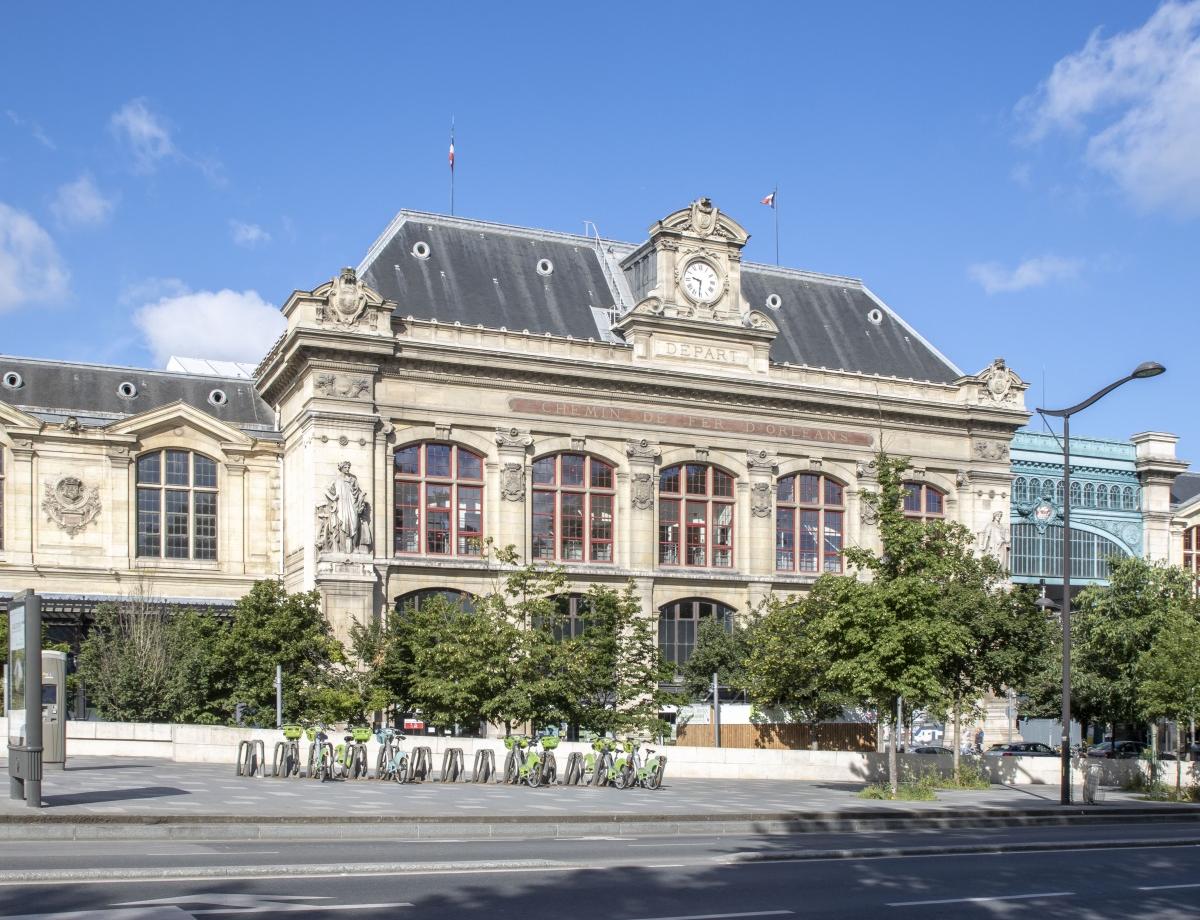
Currently, activity is concentrated on improvements for the large numbers of passengers expected during the Olympic Games this summer: simplification of the interchange between RER Line C and metro Lines 5 and 10, with new lifts and refurbished passages; construction of hundreds of parking spaces for bicycles; and establishment of 7,000m2 of new concourse areas, shops and restaurants.
Culmination of the renovation project will be installation of a zeppelin-shaped structure inside the grande halle to provide extra space for commercial outlets, celebrating the origins of the building that hosted military and observation balloons during the Franco-Prussian war of 1870.
Photos: ©France 3 Limousin/Cécile Descubes.
News in Brief
Grand Est creates rolling stock company. Grand Est région has set up a new public company, Grand Est Mobilités, that will take on formal ownership of the TER fleet from SNCF Voyageurs and be responsible for maintenance and the acquisition of new rolling stock. Grand Est Région is the majority shareholder in the new company with which it has a 42 year concession agreement. The move has enabled Grand Est Mobilités to secure a structured financial arrangement for €1.2 billion with a consortium of lenders including the European Investment Bank (EIB), Caisse des Dépôts et Consignations (CDC), an institutional investor, and five commercial banks, including Crédit Agricole Group.
Grand Est stock delayed. Transfer from Normandie région of 16 Z 26500 TER2N NG five-car double-deck EMUs currently used on Rouen – Paris semi-fasts has been delayed due to late delivery from Alstom of their Régio 2N replacements (Class Z56800). Thus extra capacity on the Épinal – Nancy – Metz – Luxembourg service cannot be introduced this year as planned. Construction of the new TER maintenance centre or these trains at Montigny-lès-Metz is due to start shortly, the €105 million cost funded 50:50 by Grand Est région and the Luxembourg government. The depot, opening in 2026, is being built on the site of the former Ateliers de Montigny-lès-Metz wagon works demolished in 2019.
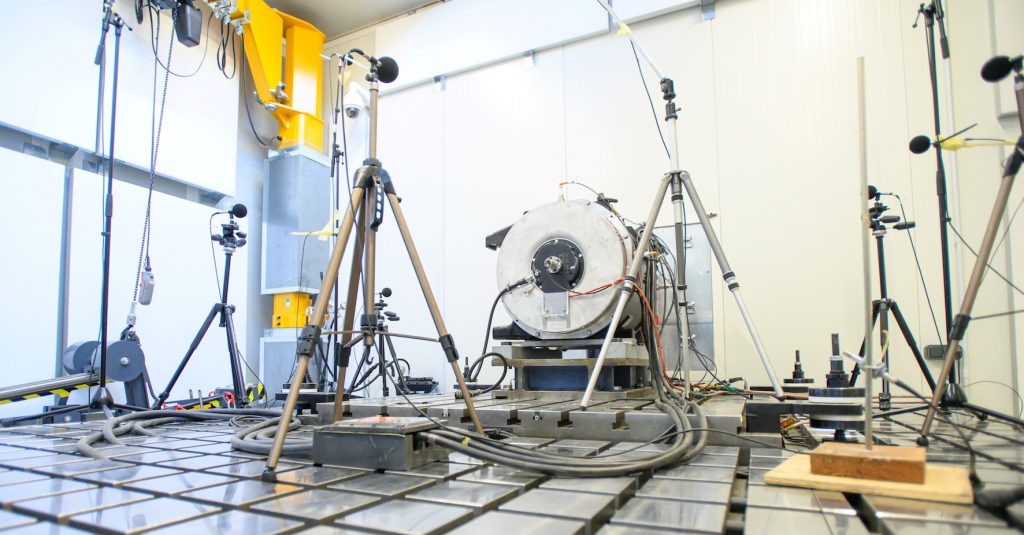
Traction test bench. Alstom has commissioned a 2MW test bench at its Ornans facility in Doubs. Intended for tomorrow’s faster-running traction motors, the equipment will validate new engines in extreme conditions and assess designs for reduced energy consumption and lower noise and vibration levels. The Plan de Relance contributed €400,000 towards the €1.4 million cost. Ornans is Alstom’s centre of excellence for traction motors and alternators, producing some 2,000 annually. Photo: Alstom/William B.
Paris – Dijon. In the latest stage of resignalling the Paris – Dijon classic line, work is underway between Nuits-sous-Ravières and Fain-lès-Montbard (24km). Modernisation of signalling, power and telecommunications will see 120km of new cable installed, replacement of 43 signal heads and installation of 21 equipment cabinets. On completion at the end of the year, the section will be controlled from Dijon CCR (see July 2023 News).
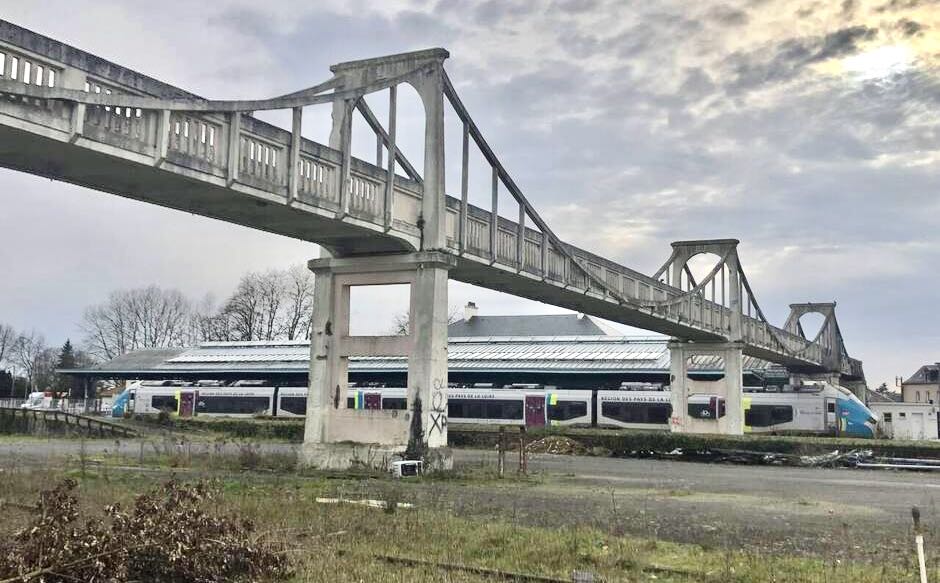
Cholet. The concrete footbridge across the station tracks, closed since 2022 because of its poor condition, is to be refurbished. SNCF and Cholet ville disputed ownership and responsibility; on 30th January the Tribunal Administratif de Nantes determined that the work should be paid for by SNCF Réseau. Photo: Ouest France.
Tours – Chinon. The ‘improved’ timetable introduced following last year’s closure for upgrading sees nine trains and two buses replaced by 10 trains, but merger of the first two morning services from Chinon has angered commuters who must now cram themselves into one train. Oddly for this prime tourist area, there are only four trains on Saturdays.
Saint-Germain-au-Mont-d'Or. A four-storey carpark is to be built at this Lyon suburban station at a cost of €12.8 million. Most of the 420 spaces will be reserved for long-distance park-and-ride and carpoolers. Fastest journey time to Part-Dieu is 13min.
Neau. Proposals for closure of five level crossings on the D32 road between Évron and Montsûrs on the line from Le Mans to Laval, discussed for 20 years and abandoned last year on cost and environmental grounds, have been revised to concentrate on that in the village of Neau, considered the most dangerous. It is likely to be replaced by a bridge but not until 2029.
Mendy. Logistics group Mendy has started a Mouguerre (Bayonne) – Lyon service to carry building materials for construction of Lyon’s T6 North tramway. Operated by Mendy subsidiary Ederlog with Fret SNCF, the weekly train will also provide a link to the Rhône valley for Spanish traffic.
Mâcon. Modernisation work at Mâcon gare is taking place overnight during three periods through to 16th December, renewing 2km of track and three turnouts with 1,900 sleepers and 3,000 tonnes of ballast. SNCF Réseau is funding the €6.8 million cost.
Ministerial changes. On the 8th January Clément Beaune resigned as Minister of Transport. He is replaced by Patrick Vergriete, previously deputy housing minister and a former mayor of Dunkerque
Winter holiday strike. Despite another one-off payment of €400 for nearly all SNCF personnel announced on 8th February, contrôleurs went on strike over the weekend of the 16th, start of the winter holidays for many. About 50% of TGV, Ouigo and Intercités were cancelled; of the forecast 1 million weekend passengers, some 150,000 were unable to travel. The payment was said to be in anticipation of excellent financial results for 2023, but SNCF president Jean-Pierre Farandou had hoped it would ease the threatened industrial unrest, pointing out that pay had risen by 17% over the past three years, against inflation of 13.2%. This round of strikes has caused particular outrage, with one senator suggesting withdrawal of workers’ rights for a certain number of days annually. For the weary French public, it is a reminder that there has been no year free of train strikes since 1947.
Flight ban upheld. The Conseil d’Etat has upheld the ban on flights of less than 2h 30min duration when a rail alternative exists, introduced last May. The airports industry association (UAF) challenged the ban as anti-competitive and incompatible with EU regulations, but judges disagreed; the law will be reviewed in 2026. Some flights from Paris to Nantes, Lyon and Bordeaux have been withdrawn.
Winter holiday strike. Despite another one-off payment of €400 for nearly all SNCF personnel announced on 8th February, contrôleurs went on strike over the weekend of the 16th, start of the winter holidays for many. About 50% of TGV, Ouigo and Intercités were cancelled; of the forecast 1 million weekend passengers, some 150,000 were unable to travel. The payment was said to be in anticipation of excellent financial results for 2023, but SNCF president Jean-Pierre Farandou had hoped it would ease the threatened industrial unrest, pointing out that pay had risen by 17% over the past three years, against inflation of 13.2%. This round of strikes has caused particular outrage, with one senator suggesting withdrawal of workers’ rights for a certain number of days annually. For the weary French public, it is a reminder that there has been no year free of train strikes since 1947.

Dormans. Work started on 15th January renewing track and pointwork at Dormans, west of Épernay, in a project lasting until May. No trains will call at the station between 09.30 and 16.30 Monday to Friday. Photo: Georges Turpin.
Battery EMU. Final trials of Alstom’s battery EMU conversion took place from December to February, prior to application for a safety case. The set destined for Région Sud PACA was at the CEF2 test centre near Bar-le-Duc for trials coupled to a second unit and validation at 160km/h. Public service is scheduled to start with December’s timetable change, when the Nouvelle-Aquitaine set is expected to run between Bordeaux and Mont-de-Marsan. Total cost of converting the five pre-series AGCs is €40.2 million, shared between the five sponsoring régions.
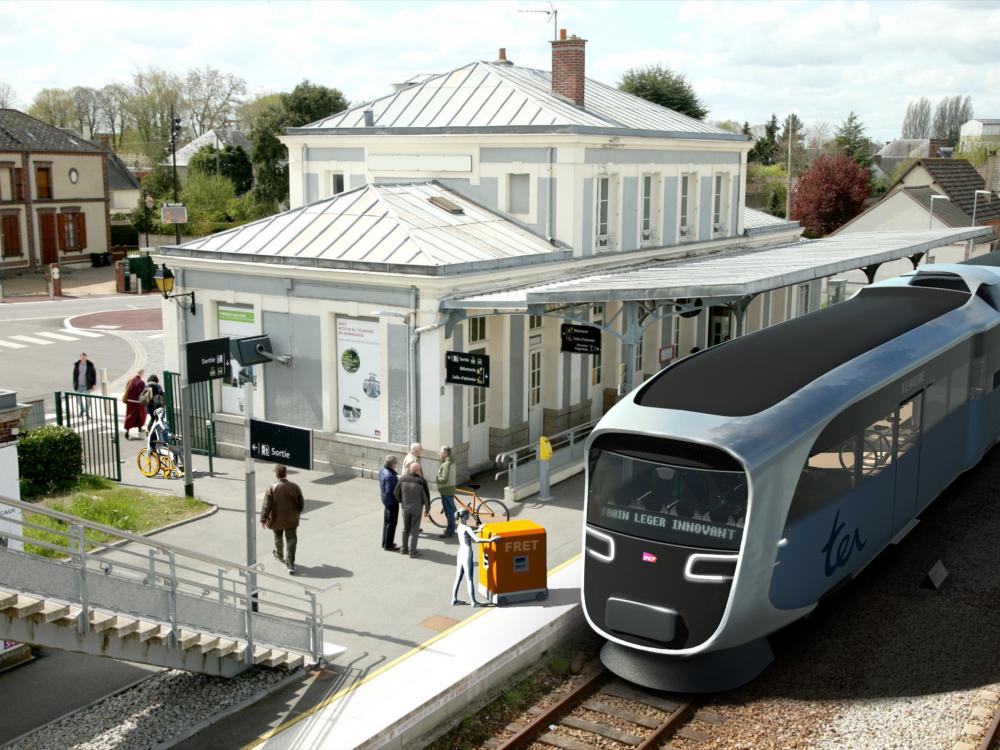
Digne – Saint-Auban. A local working group is to be set up to plan for reopening of the 22km branch from Château-Arnaux-Saint-Auban to Digne, closed in 1991, possibly using one of the technologies being developed in the Train Leger Innovant project (see December 2022 and February 2023 News). It is hoped that the line could be used for trials of the TELLi battery-powered light railcar next year. Photo: SNCF
Bagnols-sur-Cèze. Renovation of the southbound platform and building is expected to be completed in April. Work continues on the associated multimodal interchange and car parking due to open next year.
More tax rebels. Sixty communes in Lot département have joined complaints against a tax contribution towards the cost of building the Toulouse LGV. These are situated north of the proposed Montauban LGV station, within 1h driving time by toll motorway. They are currently served by stations on the POLT or Toulouse – Figeac – Brive lines, into which they would rather see more money invested.

Lyon – Turin Update
At the end of January the French Government submitted their co-financing application to the EU for the preliminary studies for the French section of the Lyon – Turin high speed line. The application seeks €90 million in EU funding for the €220 million cost of the preliminary work on the first stage that will enable the project to be put out to tender for the €8 billion construction phase. This does not include the link to Chambery (shown in green on map) that will be covered in stage 2. The result of the application should be known in June.
A condition of the application was that it contained a co-ordinated financing plan for the amount payable by France. Following some last-minute negotiations between the state, region and local municipalities, concluded only 24 hours before the 30th January deadline, Région-Auvergne-Rhône-Alpes (AURA) increased their contribution by €20 million. The final amounts were AURA €33 million; Departs of Savoie 3 million and Rhône €1.5 million; Agglomeration of Annecy €1 million; Chambery €1 million and Aix-les-Bains €300,000. The Métropole de Lyon will contribute €5 million to the CFAL section (brown on map). The remainder will be met by the state. The move was seen as a positive step by Italy and other stakeholders in the Transalpine project following concern over French commitment to the new line.
At the end of January the fourth of seven tunnel boring machines was handed over at Herrenknecht's Schwanau factory in Germany. The 3,200 tonne machine has a diameter of 10.4 metres. It will be used on the 18km cross-border section between Villarondin/Bourget-Modane in France and the Clareau safety cavern in Italy.
On the traditional Maurienne route, closed since the landslide last August at the La Paz cliff just north of Modane, work has started on removing the thousands of tonnes of rocks and debris piled up on the galleried section. To avoid the risk to workers from further rockfalls or the gallery collapsing SNCF Réseau is using remotely controlled excavators fitted with cameras. A team of twelve operators located in a nearby portakabin are able to operate the machinery night and day using video game like joysticks. The line is now expected to re-open in November.
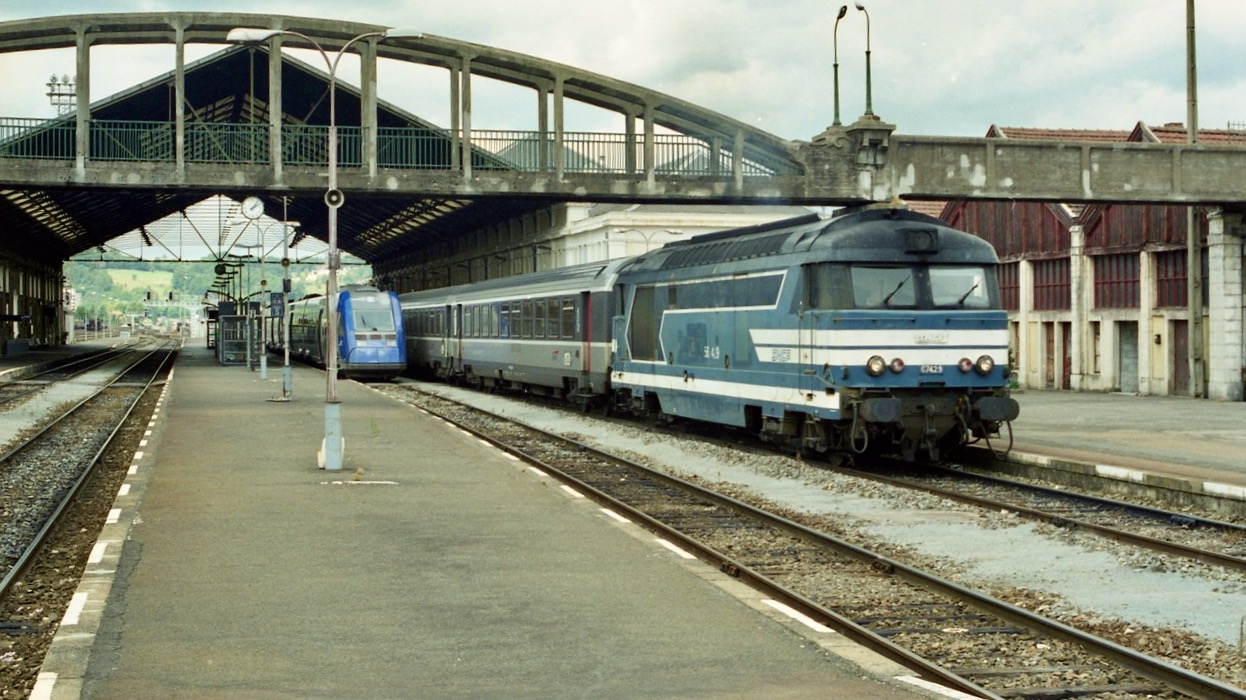
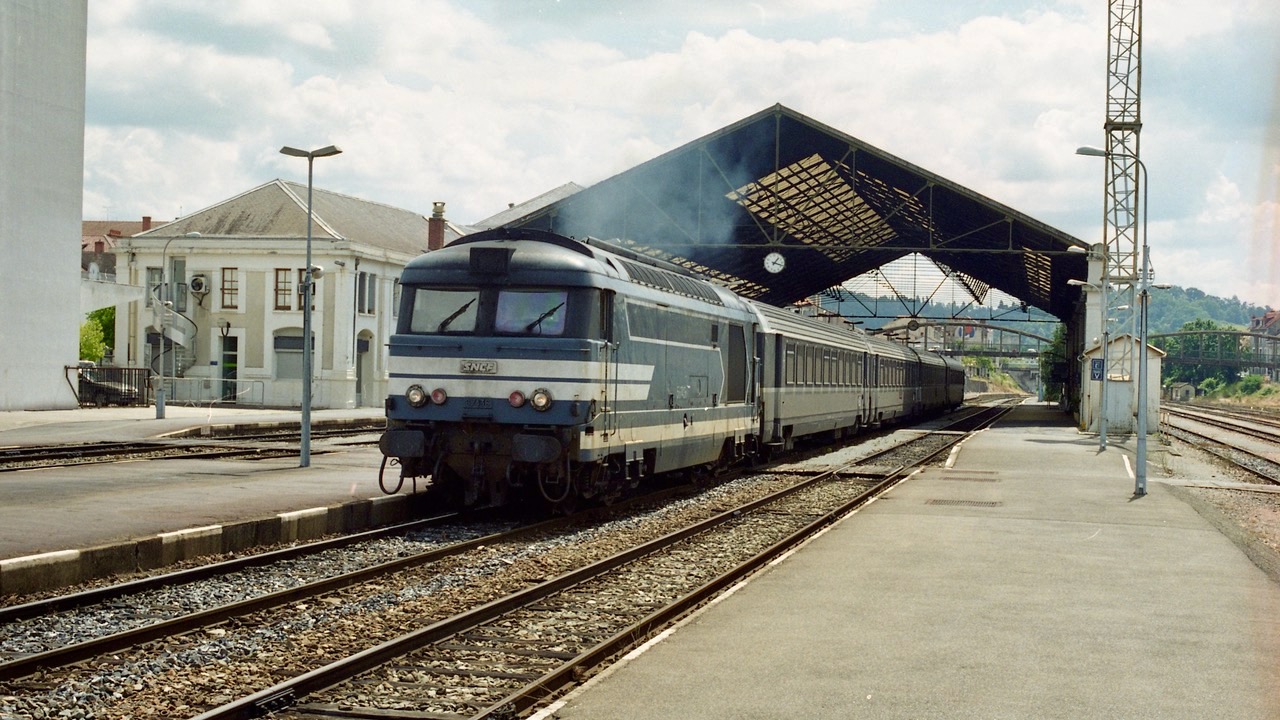
Agen – Périgueux Decline
At Monsempron, two DMUs layover at night for early morning departures to Agen plus a third at weekends for a Mondays-only run to Périgueux, their crews lodging in a hotel at nearby Fumel. Since February, the local taxi contract has been replaced by one based in Cahors, necessitating a round trip of 100km twice daily to convey the crews 3.3km to and from the hotel. Staff have complained of the absurdity.
Above. The summer-only night train to and from Paris was withdrawn in the late-1990s but in 2000 the line still enjoyed a daily direct service between Agen and Paris with coaches attached/detached to Paris – Toulouse services at Limoges. The south and northbound services with BB 67429 and BB 67436 are seen at Périgueux in August 2000.
Competing visions for Toulouse – Castres
Opponents of the A69 motorway under construction between Toulouse and Castres are continuing to press for upgrading of the railway to Castres and Mazamet as an alternative. Studies made for La Voie est Libre and other pressure groups suggest that expenditure of €100 to €150 million on additional infrastructure, passing loops and signalling improvements could provide for a half-hourly service to Castres. This contrasts with Occitanie région’s study for complete route-modernisation and electrification, without which it believes it would not be possible to run a sufficiently attractive, fast and environmentally-friendly alternative to the motorway. Today’s best timing from Castres is 1h 07, against the Google Maps estimate of 1h 27 by road.
Although timings would be somewhat constrained by the remaining single-track sections between Toulouse and the junction at Saint-Sulpice-Tarn, also used by Rodez and Figeac services, the three passing loops on the 55km thence to Castres would already allow an increase in frequency above the current 12 daily trains. Line speed is 140km/h between Saint-Sulpice and PK275, east of Lavour, but limited to 80km/h thereafter. At Castres, trains reverse for the short run to Mazamet (19km). Operating this as a shuttle connecting with Toulouse trains has been suggested as another way of easing capacity constraints, though one hardly likely to appeal to Mazamet passengers (70,000 annually), even with cross-platform interchange at Castres.
Occitanie’s proposal comprises track-doubling throughout between Toulouse and Castres (€827 million), electrification between Toulouse and Mazamet (€105 million), resignalling between Lavaur and Mazamet (€47 million), and widening of Campmas and Seilhan tunnels (€163 million). At roundly €1 billion, the scheme has been dismissed as too costly for the région to undertake. The pressure groups are seeking a review of the estimates and the rejection of their own proposals, which they feel is at variance with the région’s generally pro-rail stance.
Opposite. A previous upgrade of the Castres line completed, on 21st July 2015 Régiolis No B83531/2 has arrived at Mazamet on a mid-morning service from Toulouse. Track, signalling and accessibility works had been carried out prior to introduction of Régiolis MUs. Now terminus of the service from Toulouse and Castres (reverse), Mazamet was formerly a through station on the cross-country route from Montauban to Bédarieux and Montpellier which closed beyond Mazamet in 1972.
Photo: Chris Bushell.
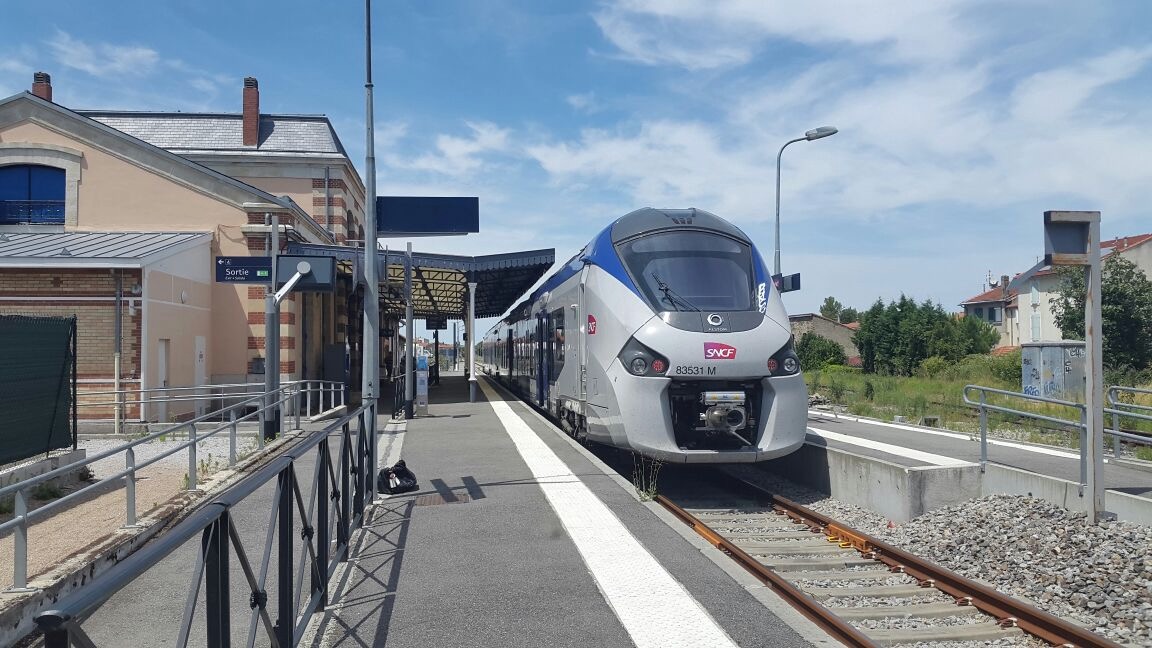
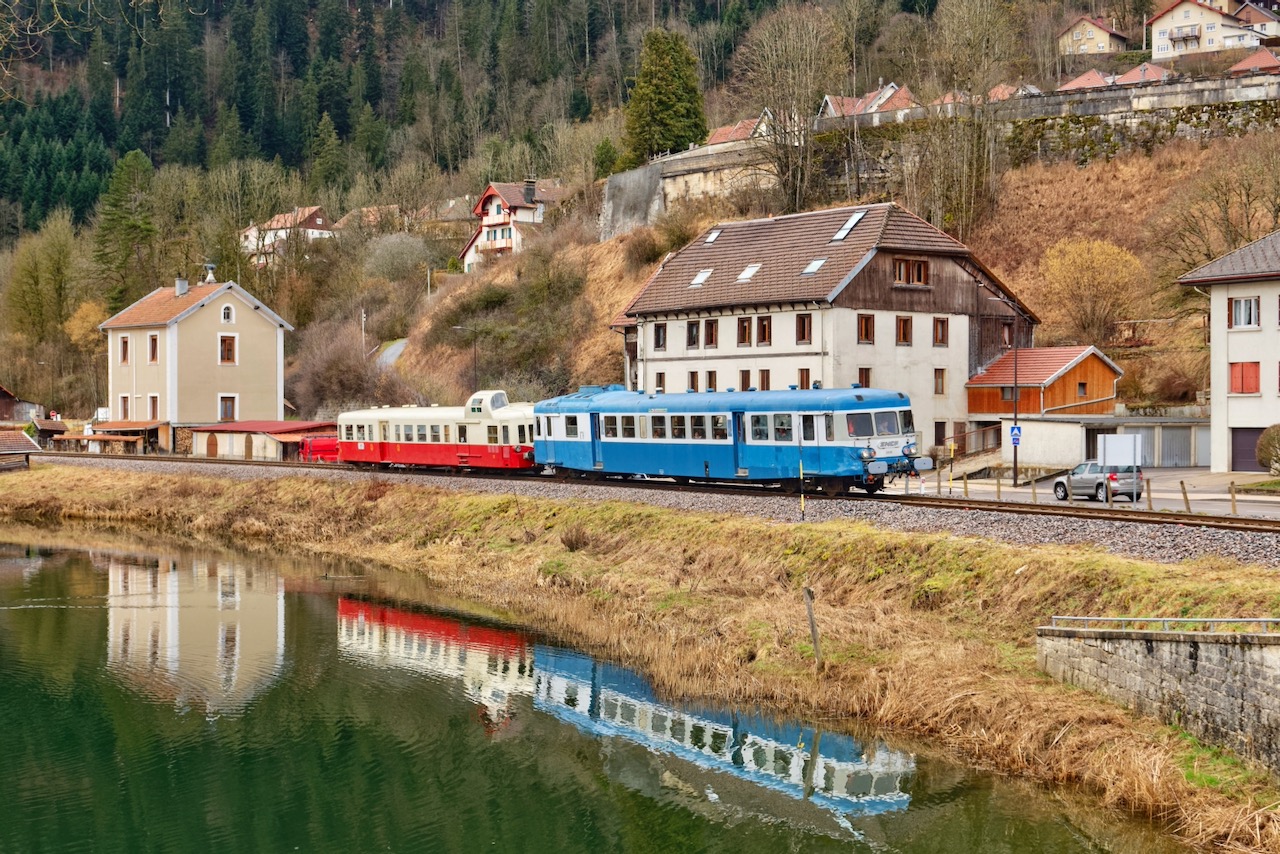
The first railtour of the season took place on Saturday 17th February with ABFC X4039 visiting the Jura and Doubs from Dijon. Between Besançon and Morteau X4039 ran with X2816 preserved by l'Autorail X2800 du Haut-Doubs.
The pair are seen above approaching Morteau and opposite X4039 is passing through Arc-et-Senans on the return.
Photos: Erwan Quintin.

Napoleon Express extended
La Mure T9 overhauled

T9, the third of Petit Train de la Mure’s 1932-vintage Sécheron electric locos, was returned to service at La Motte d’Aveillans on 26th January following renovation by ACCM Clermont-Ferrand. Photo: Le Dauphiné Libéré/Estelle Zanardi.
Carte Touristique restored
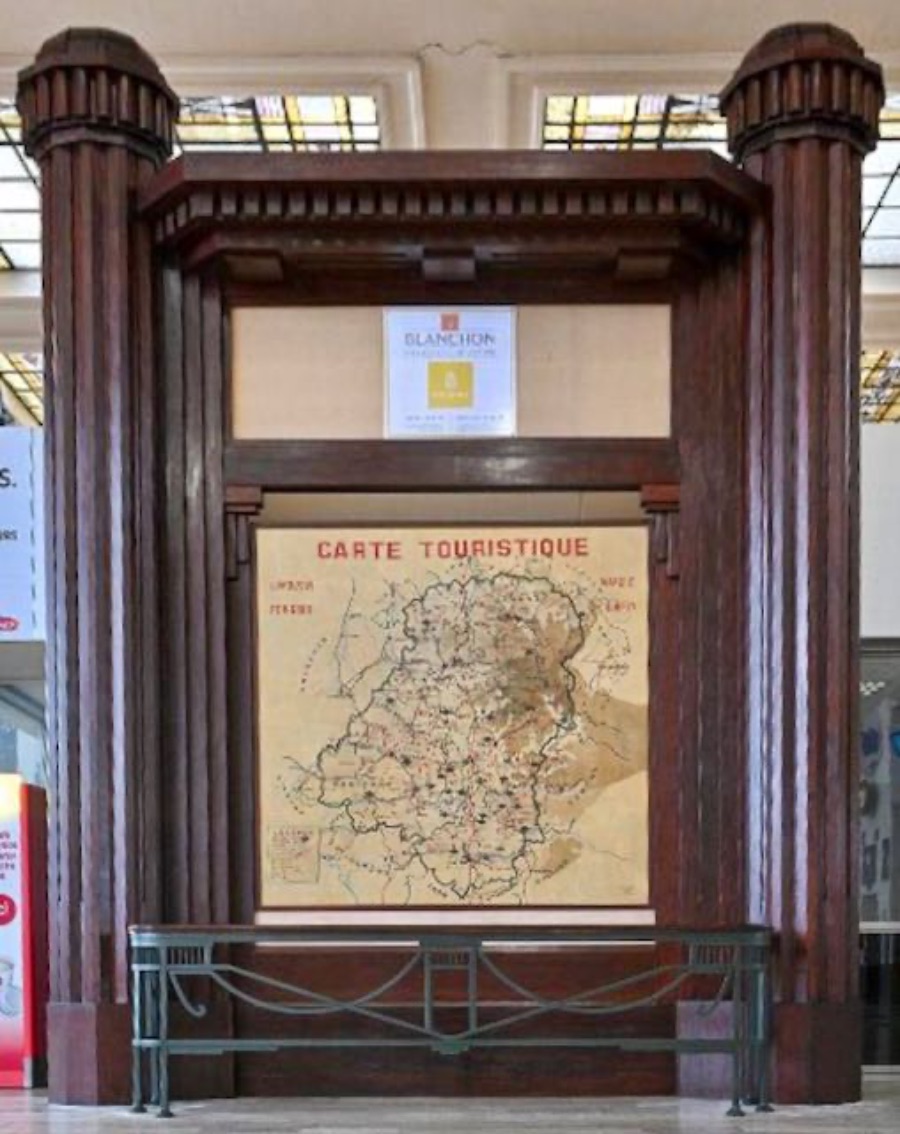
The art deco wood and canvas carte touristique dating from 1929 has been restored and is once again on display at France’s most beautiful station, Limoges Benedictins (voted in 2022). Secretly preserved by railway staff since the 1970s, the panel was originally part of the carved-timber ticket office partition wall. The buffet here reopened last November after several years’ closure.
Photo: Le Populaire du Centre/Stéphane Lefèvre.
241 P 9
Work on the re-assembly of 241 P 9 continues inside the former depot at Toulouse Matabiau, where it is the sole occupant. Since the photo opposite was taken in December the wheels have been aligned and the connecting rods fitted.
The locomotive must be moved by September when the depot is due to be demolished as part of the Grande Matabiau development. At present a new location has yet to be found.
Photo: Georges Turpin.

Off the beaten track
In the northwest suburbs of Bordeaux at Saint-Médard-en-Jalles the station on the old line to Lacanau (see February news) still exists next to a children's play park. Amongst the play items is a wagon and Belgian 030 T MF 82 Couillet 1706/1913 originally employed by the coal mine at Monceau-Fontaine, near Charleroi, and arrived via CF3V at Mariembourg. Photo: Georges Turpin.
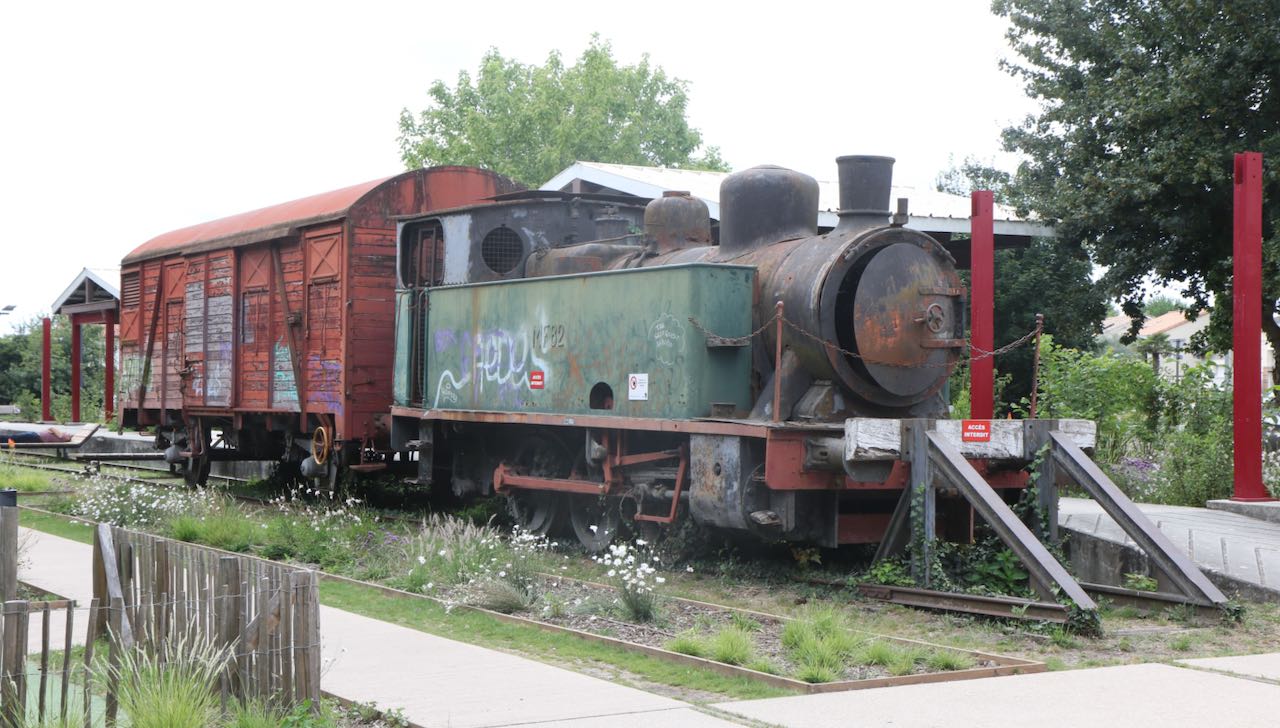
SNCF suspends Transilien heritage operations
SNCF has informed AJECTA that it no longer has the management time and resources to facilitate heritage operations in the Transilien area. Although full details are not clear, the move would also seem to affect AAPSL (BB 17016) and MFPN (231 K 8, BB 69432 and CC 40110) which are both Paris-based, and could have some impact on AAATV at Orléans and PVC at Rouen, both of which run some of their trips into the Paris area.
While AJECTA has cancelled its Easter trains from Longueville to Romilly-sur-Seine, MFPN states that it is working with UNECTO and SNCF to secure the 2024 programme and is confident that future operations will be unaffected. The move comes as a second blow to AJECTA. At the end of last year, SNCF closed the line to Villiers-Saint-Georges beyond Provins. This only saw occasional cereals traffic and was otherwise available for AJECTA to use.
Mars 2024 News
Urban Rail
Line 4 automated, Line 13 next
Automation of Line 4 in Paris was officially inaugurated on 19th January by IDF Mobilités president Valérie Pécresse and Jean Castex, head of RATP. The result of 10 years’ work, the city’s second busiest metro line has been converted to Grade of Automation 4 (GoA4) with full unattended operation. Castex said that the €480 million project had been more challenging than conversion of Line 1 in 2012, which highlighted RATP’s ability to bring the benefits of automation to 19th century metro infrastructure without lengthy periods of closure. A particular challenge was ensuring compatibility across the three different types of rolling stock in use. Minimum headway is now 85sec, with a train running every 105sec in normal service.
Line 13 will be next for automation, presenting different challenges on account of its two branches and frequent overcrowding. Approved in 2022, the first contracts are expected to be signed shortly, with work starting next year for inauguration in 2033. On the horizon but still at the planning stage is automation of Lines 7, 8 and 9.
On 6th February Île-de-France Mobilités announced plans to order a further 103 sets of MF19 stock from Alstom at a cost of €1.1 billion. For delivery starting in 2027, the first batch will replace MF77 stock on Line 13 prior to automation. Later batches will replace MF67, MF77 and MF88 stock on Lines 3, 3bis, 7, 7bis, 8, 10, 12.
----------
Some of Line 4’s trains have been fitted with dummy controls so that children can ‘play driver’. Notice there’s no steering wheel as was proposed in January for similar installations on London’s Docklands Light Railway trains.
Photo: Le Parisien/Benoît Hasse

Rennes update. The first replacement components for Line B’s bogies arrived on 31st January and fitting started in mid-February at the Limoges works of a Siemens sub-contractor. Siemens replacing all 100 ‘mechanical blocks’ on the 25 trains rather than just the part which caused the breakdown (see item in February News). After initial reticence, this has been identified as a small component in the axles. Ouest France reported in late-January that the metro safety body had not received a report on the cause of the incident, and cast doubt on the ability of Siemens to complete repairs within three months. Several sources have suggested that the incident involved the train losing contact with the single central guide rail, a problem believed to have been amongst those responsible for the two-year delay in commissioning Line B.
Photo: Rennes Métropole.
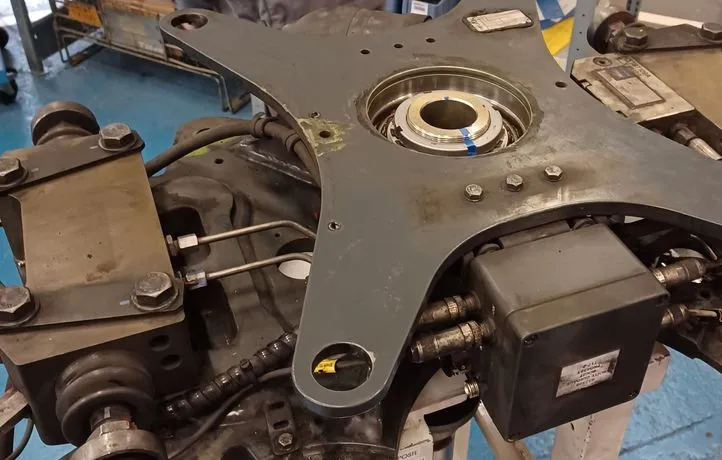
Nice mess. A tramcar on Nice’s Line 2 was derailed on 15th January after being hit by a commercial vehicle being driven at excessive speed. The driver, who was later found to be almost four times over the alcohol limit, had already passed a red traffic light and committed several other traffic offences. The tram was running empty to depot; no one was injured. A fortnight later, a police car became stranded on Line 1 track at Jean Médecin.
Nantes tramway. The first of Naolib’s new trams was shown to the public on 19th January. After some delay due to ‘technical problems’ at Alstom, 14 should be in service this year on Line 1. A total of 61 Citadis X05 cars are being supplied under contracts awarded in 2020 and 2021. Naolib carried 146 million passengers in 2023, almost back to the pre-covid record of 148.6 million achieved in 2019.
Bordeaux. Amongst the problems causing Bordelais to press for a metro to relieve the overcrowded tram network, TBM is grappling with the nationwide shortage of drivers and maintenance staff. Despite recruitment of 80 drivers in 2023, the network needs a further 100, while on some days fewer than 100 of the 108 rostered trams are available due to maintenance backlogs. Operator Keolis hopes to recruit 245 drivers and technicians this year.
Brest Line B. A consortium of Colas companies and Aximum has been awarded a €62 million contract to build Line B of Brest’s tramway, linking Gare SNCF with CHRU de La Cavale Blanche. The 5.1km line with 11 stops will connect with Line A in the city centre. Opening is scheduled for early 2026.
Lille loses. The administrative court of Lille has rejected the Métropole’s claims against Alstom concerning the late-running renewal of Line 1’s automation and delivery of new cars, scheduled for 2016. Alstom said that the project is in the final stages of implementation.
Transport industry recruitment – Toulouse style
Like elsewhere in France, Toulouse has numerous vacancies in the transport industry. On Thursday 8th February Le Tram de l'emploi , Tisseo 5009 specially decorated for the occasion, ran between the Palais de Justice and MEET terminals with recruiters on board ready to meet potential candidates. Other recruitment stands were set up at Arènes station. Photos: Georges Turpin.
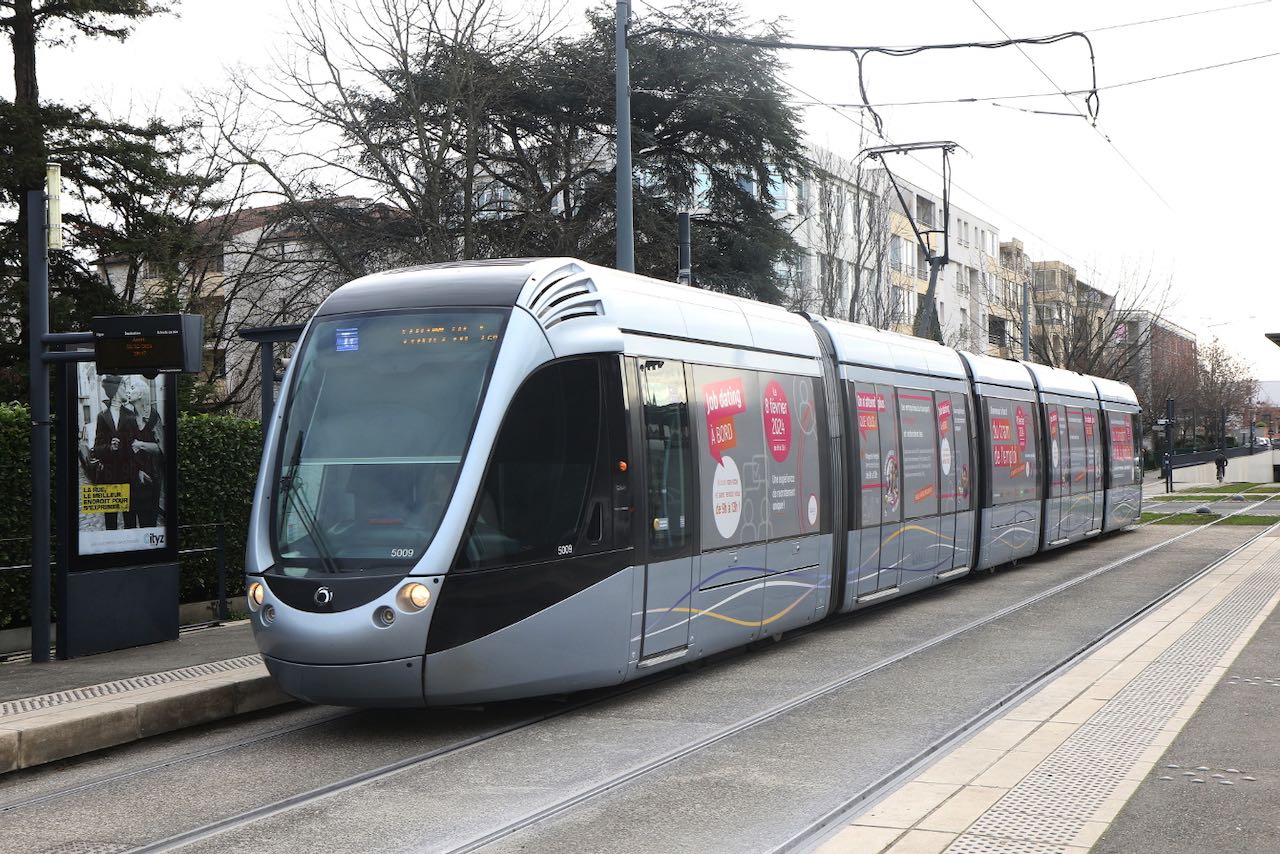
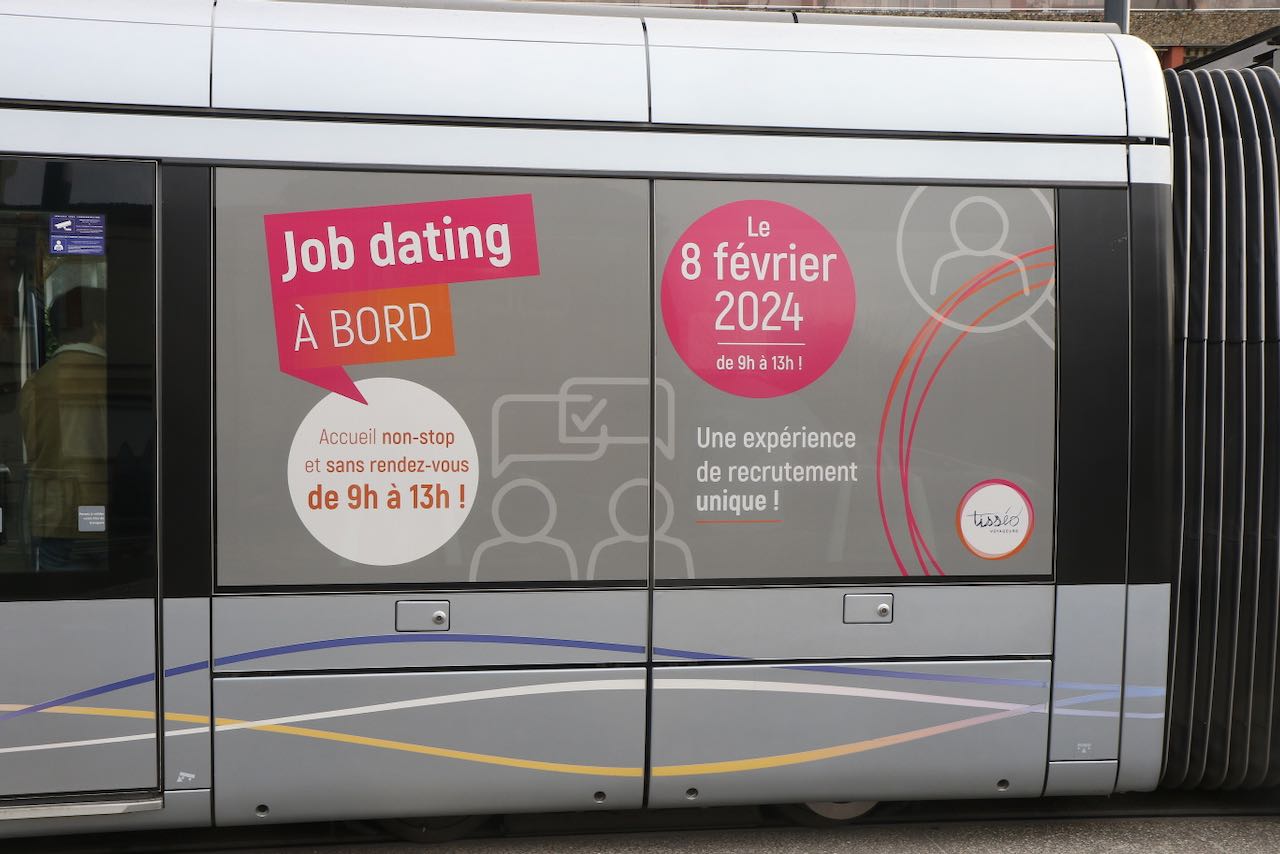
Additions to FRS Photographic Archive during February 2024
To Photographic section
To Locations section
To Locations section
- LVDR 817/Oct 1971 - Electrification Marne Valley
- LVDR 817/Oct 1971 - Electrification Oise Valley
- LVDR 1801/July 1981 - Montpellier
- LVDR 854/July 1962 - Electrification Dijon – Neufchâteau
- LVDR 719/Nov 1959 - Loriol – Avignon électrification
- LVDR 732/January 1960 - Thionville – Apach electrification
- LVDR 739/March 1960 - Sarrebourg – Blainville electrification
- LVDR 857/July 1962 - Tarascon – Marseille electrification
© Peter Lovell & Chris Bushell. The French Railways Society 2024. With thanks to Georges Turpin, Didier Delattre, David Haydock and Erwan Quintin.
